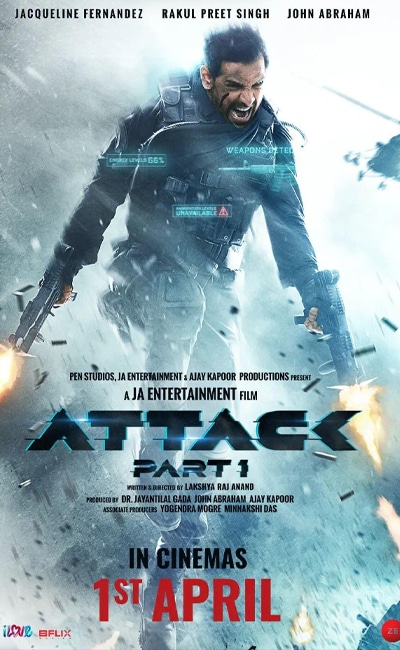
CAST:Jacqueline Fernandez, Rakul Preet Singh ,John Abraham
DIRECTED BY : Lakshya Raj Anand
BLUF: While battling his personal inner demons, an army veteran volunteers to become part of a governmental experiment to become a cybertronic humanoid super-soldier developed to combat terrorism.
THE MEAT AND THE POTATOES
The innovators behind objects like the cellphone or the helicopter took inspiration from works like “Star Trek” and War of the Worlds.
In Attack Part 1, Arjun meets Ayesha (Jacqueline Fernandez), an air hostess, and they fall in love. In a terrorist takeover of an airport terminal, Ayesha is killed and Arjun suffers paralysis from the neck below. Meanwhile, Subramanyam (Prakash Raj) a high-ranking official in the government is trying hard to push for the human-testing of the AI-powered super-soldier program, R&D of which is headed by Saba Qureshi (Rakul Preet Singh)
The paralyzed soldier Arjun Shergill’s only hope to normalcy may be becoming a part of this Indian Government’s stealth program to be a Super soldier. His brain would function off a chip inserted invasively into his body, designed to take over motor commands and work with his own personal command center assisted by his own IRA.
The fun begins when just after his surgery, Arjun has to extract the Prime Minister of India from a terrorist attack on the Parliament Building. As he enters the building to save over 300 civilians, the PM and other politicians taken hostage inside the parliament by Hamid Gul (Aghan actor Elham Ehsas , The Kite Runner), a dreaded terrorist.
Pacey, credible storyline, full of thrills, brilliant action direction and some kickass VFX puts Attack Part 1 in a very watchable zone but what makes it worth your while will be drooling over the very very very hot Mr Abraham who looks every inch as drool-worthy if not more as he was swooning to beats at Miami’ South Beach with Priyanka Chopra in 2008
IN THE KNOW
Technology is accelerating, and we are entering the fourth industrial revolution, called the biological revolution.
Martin Cooper, the director of research and development at Motorola, credited several “Star Trek” technologies as partial inspiration for the design of the first mobile phone in the early 1970s.
Apple scientist Steve Perlman says that he got the idea for the groundbreaking multimedia program QuickTime after watching an episode of “Star Trek: The Next Generation,” wherein one of the characters is listening to multiple music tracks on his computer.
Neal Stephenson’s 1992 novel Snow Crash describes a fully immersive online “Metaverse” where people interact with one another through representations called “avatars.” Philip Rosedale, the inventor of the once popular online community Second Life, had been toying with the idea of virtual worlds since college, but credits Snow Crash for painting “a compelling picture of what such a virtual world could look like in the near future, and I found that inspiring.”
In Stanley Kubrick’s science fiction masterpiece “2001: A Space Odyssey,” the astronauts carried handheld computers that contained all the information they could possibly need. In the “Star Trek” movies and television shows, crew members had PADDs, which stood for Personal Access Display Device. Both of these are examples of the earliest conceptions of tablets.
Movies like “iRobot” and “Total Recall” presented the idea of driverless vehicles
One of the first uses of a hologram to represent a person was the iconic scene in “Star Wars: A New Hope,” when Princess Leia’s image is projected out of R2D2. This is going to be the future of our human interaction very soon.
Devices that transport the user to a computer created reality, virtual reality, are also common in science fiction movies. In “Total Recall,” “The Matrix,” and “Surrogates” characters plug in to virtual realities in complex chair setups that connect the whole body to the VR. Other movies, like “Lawnmower Man,” “Hackers,” and “Johnny Mnemonic” envisioned virtual reality headsets that the user put over their eyes to see a virtual world. This is the vision (pun intended) that has come to pass. The ultimate in computer technology in science fiction is the gesture activated computer screen. Spielberg portrayed this masterfully in “Minority Report” and Iron Man’s computer is the envy of all.
Now, lets talk about Super Soldiers.
Is it a possibility as elucidated in Attack Part 1.
The explosive popularity of the Marvel Cinematic Universe led some in the defense industry to pursue Iron Man-like combat suits for American troops. While there are some viable prototypes in the works, it looks like we may get parts od Captain America’s “super soldier” program done soon enough.
You can now inject engineered blood to boost performance, using artificial red blood cells, called respirocytes.
Nightvision could also be injected directly into eyes using nanoparticles that convert infrared light to visible light directly into the eyeballs. DARPA (the Defense Advanced Research Projects Agency) was already experimenting with helmets that would allow for “silent talk.”
Now with all of this and more from companies like Neuralink that are working on recording from electrodes in the subject’s motor cortex, which correspond to neurons involved in planning the subject’s hand movement.
China has already begun “human testing” on members of the People’s Liberation Army with the intention of developing soldiers with “biologically enhanced capabilities. China’s apparent use of the gene-editing tool CRISPR, which is short for “clusters of regularly interspaced short palindromic repeats” to increase human capabilities on the future battlefield remains only a hypothetical possibility at the present, there are indications that Chinese military researchers are starting to explore its potential.
With this movie, John Abhram pivots the story of bollywood fighting terrorists to its rightful age of bio warfare and it is fun to watch, credible and current in its tech research and when enacted by good actors, sets a standard which other movies in this genre will need to now come close to.
The movie is recommended.




